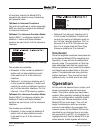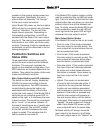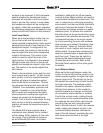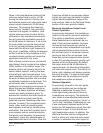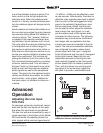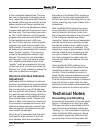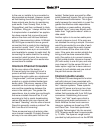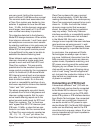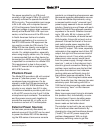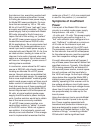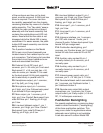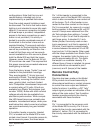
Model 233 User Guide Issue 1, September 2007
Studio Technologies, Inc. Page 35
to the user or installer to be connected or
disconnected as desired. However repeat-
ed field testing found that floating pin 1 on
these outputs was the key to maintaining
quiet audio. From Fenway Park, to the
Orange Bowl, and then northwest to Husk-
er Stadium, lifting pin 1 always did the trick.
A simple solution is available if an applica-
tion does require that a ground be avail-
able on the main and line-level talkback
outputs’ interconnecting cables. All Model
233 XLR-type connectors have a ground
connection that is made to the interfacing
connector’s metal “shell.” And most XLR-
type connectors have a pin or connection
point available to access its metal shell. By
connecting the cable shield to the mating
connector’s shell terminal, the common
connection typically found on audio inter-
connections is created.
Intercom Channel Crosstalk
By the very nature of its design, a
2-channel party-line intercom circuit is
prone to exhibit crosstalk. This occurs
because the audio paths are unbalanced
(“single-ended”) and are typically trans-
ported on a single shielded twisted-pair
audio cable. The primary causes of the
crosstalk are the common signal return
wire and the capacitance between the
wires in the cable pair. The greater the
capacitance, due to cable type and length,
the more crosstalk there will be. It’s not
surprising to find in sports broadcasting
venues that audio from one channel can
be heard “bleeding” into the other channel.
Does this generally create a problem? No.
But it can be a bit unnerving.
There are several ways of reducing inter-
com channel crosstalk. Probably the easi-
est way is to use cable pairs that are not
twisted. Twisted pairs are great for differ-
ential (balanced) signals, but not so great
for unbalanced transmission. This is gen-
erally because the more twists in a pair the
greater the effective cable capacitance.
In a stadium or arena setting, choosing
standard “telco” pairs may actually work
better than “high-performance” audio or
data cable!
Another option is to use two cable pairs
for each intercom circuit. If the pairs are
not shielded the wiring is simple. Common
would be connected to one side of each
pair, and then signal from each channel
would connect to the other side of the
pairs. If the pairs also contain shields the
wiring could be done somewhat differ-
ently. One option is to connect common
to both cable shields, intercom channel 1
(DC with audio) to one full pair, and inter-
com channel 2 to the second full pair. A
better option might be to have common
connect to both shields and one side of
the pair that serves channel 2.
Intercom Audio Levels
The Model 233 was designed to function
well with intercom lines associated with
standard broadcast and production “party-
line” intercom systems. These systems
provide DC power and one or two chan-
nels of audio over standard 3-conductor
cables that terminate with 3-pin XLR-type
connectors. Establishing the correct
“listen” and “talk” levels was critical in
achieving good audio performance. In
North America the two most common
intercom systems are those from RTS
and Clear-Com. From tests performed
in Studio Technologies’ lab, the nominal
RTS TW-series audio level is approximate-
ly –10 dBu. The dynamic range control
provided by belt-packs such as the BP325




